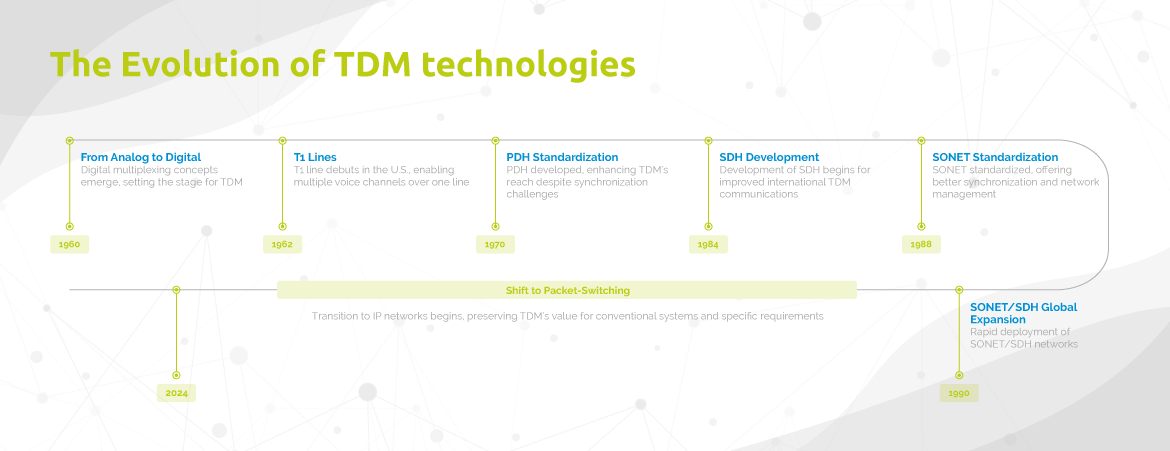08 Jul 2020
The transition from Time-Division Multiplexing (TDM) to Internet Protocol (IP) is more than just a technological improvement; it is a strategic response to the changing needs of modern communication.
This article discusses the TDM to IP switch and its significance for networks.
What are TDM (Time Division Multiplexing) technologies?
Time-Division Multiplexing (TDM) is a mechanism for transmitting several data streams over a single channel. It accomplishes this by assigning a unique time slot to each data stream, allowing them to be sent sequentially along the same channel.
TDM, which was developed to improve the efficiency of communication channels, has proven especially useful in the shift from analog to digital systems by maximizing bandwidth and simplifying data transmission.

Key TDM technologies
- SONET (Synchronous Optical Network): is a digital communication technique that rapidly transmits several data streams over optical fibers. It is well-known for its fast transmission and fault recovery capabilities.
- SDH (Synchronous Digital Hierarchy): is a global standard for high-speed communication across optical or electrical networks, comparable to SONET. It uses TDM to efficiently integrate data at various speeds.
- PDH (Plesiochronous Digital Hierarchy): is a technology that transports speech and data across digital systems but has limited flexibility due to timing issues.
- T1 and E1 Lines: T1 (in North America) and E1 (in Europe and other regions) use TDM to carry voice and data. They divide bandwidth into channels, allowing multiple calls or data connections simultaneously.
Why are companies started moving from TDM to IP?
For a long time, essential services have relied on time division multiplexing (TDM) networks like PDH (plesiochronous digital hierarchy) and SDH (synchronous digital hierarchy) within critical infrastructures.
However, network operators are concerned about managing and supporting these legacy environments and infrastructures, as many have outlived their useful lives. Nonetheless, operating procedures are getting more difficult to maintain. As repair resources become increasingly difficult to get, network operators face a shortage of equipment for scalability and expansion.
Key Drivers for moving from TDM to IP
- Security concerns: outdated network infrastructures provide increased security concerns, leaving companies more susceptible to breaches and attacks.
- Operation and maintenance costs: outdated network infrastructure leads to increased operation and maintenance costs due to frequent breakdowns and manual repairs. As a result, businesses will have to wait longer for repairs and pay more. Legacy equipment is costly to maintain.
- Backup equipment availability: purchasing older equipment can be prohibitively expensive and difficult because of its limited availability on the market.
- Vendor support: for older technology has decreased due to reduced demand and company closures.
- Knowledge and experience of the workforce: individuals with expertise in and responsibility for maintaining these legacy systems are reaching retirement age.
What is the current state of TDM to IP transition?
Nemertes1 research revealed that in 2017, 72% of companies were still using TDM infrastructure. Contrastingly, a survey by Ciena showed that among its respondents, the prevalence of TDM usage was 100%, indicating a complete reliance on legacy networks within that specific group.
Today, it’s quite possible that numerous organizations have already shifted a portion of their TDM network towards IP technologies, with the percentage of migration varying depending on their specific infrastructure needs.
Our research at SGRwin shows that a significant transition to IP technologies will take place between 2020 – 2025, driven by the critical demands for compliance, greater security, and the need to address the inherent problems of TDM networks.
How to make a swift from TDM to IP efficiently?
Preliminary financial assessment
Evaluate the financial impact of the transition and identify affected TDM services.
Actions
- Conduct a preliminary analytics project focused on TDM services.
- Analyze how the migration will affect the financial aspect.
- Use the analysis to prioritize services.
- Explore opportunities for additional revenue through new IP service features.
Calculate the total cost of ownership (TCO)
Determine the full cost of maintaining legacy equipment and services, including hidden expenses. So, this way you will be able to compare and evaluate the ROI once migration is executed.
Actions
- Assess the comprehensive TCO, encompassing the upkeep of legacy applications with manual efforts.
- Consider the costs and risks of service disruption in case of equipment failure.
- Combine the TCO analysis with insights from the preliminary financial assessment.
Implement strategic transition
Minimize downtime probability by adopting a strategic redirection approach.
Actions
- Embrace strategic redirection, intercepting incoming service orders and redirecting them to the new service when feasible.
- Utilize service analysis to guide feature implementation and coverage priorities.
- Strategic redirection reduces upfront costs and migration risk.
Develop extensive training programs
Address cultural challenges and equip network staff with the skills to handle IP services effectively.
Actions
- Offer training and opportunities to gain hands-on experience in managing, deploying, and maintaining IP services.
Commence with small-scale projects
Establish training initiatives for your team handling TDM to IP migration projects.
Actions
- Identify opportunities for small-scale migrations, such as specific regions or technologies.
- Execute TDM to IP migration as individual, manageable projects.
- Consider incorporating strategic redirection to enhance migration outcomes and mitigate issues encountered in initial stages.
What are the benefits of moving to IP technologies?
The advantages of switching from TDM to IP systems include increased operational efficiency, centralized management capabilities, and cost savings. These benefits arise from IP systems’ unified technical architecture, which enables more streamlined operations, administration, and management processes than the older TDM infrastructure.
What are the biggest challenges facing businesses when moving to IP?
Ensuring a smooth and seamless network move is vital for maintaining critical services and minimizing downtime. However, a few challenges that businesses may face include:
- Service continuity: ensuring that the transition does not interrupt existing services, which requires careful planning and execution.
- Data collection regarding circuits and services to be migrated, which are scattered among several outdated systems.
- The lack of skilled resources with capacity of managing, planning, and executing the network migration and its maintenance according to a constant network evolution.
- Financial investment: Upgrading to IP involves costs for new equipment and infrastructure, as well as potential training expenses.
How does SGRwin can help you?
We offer a consultancy service to evaluate your network requirements and help you elaborate a migration plan implementing SGRwin solution to manage your network assets.
What are the advantages does SGRwin offer?
- Supports all services including «legacy» (pre-existing). Services supported by the TDM networks which can also work in the Ethernet networks (by CES or SAToP).
- Single infrastructure to efficiently maintain and operate whilst saving operational costs.
- High flexibility to transport all kind of services, with several speeds and pack sizes.
- Bandwidth management.
- Topology flexibility.
SGRwin is designed to provide seamless network evolution
If you still not migrated to IP completely. SGRwin allows you to combine in the same system, your existing legacy network and IP network. Reducing the complexity of the network management and the number of systems used to manage these multi-technology networks.
SGRwin is an agnostic system that provides you with:
- Consolidated view
- E2E service provisioning feature
- Customised dashboards
- Events management
- Fault detection and management,
- Advanced reports
- Other key features
Further, you will be able to migrate from legacy TDM to IP under the same SGRwin system in a controlled way whilst minimising risks and reducing costs.
